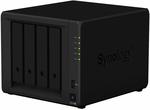Hi Guys ,
Posting my First Deal here. I have been keeping an eye on the price of Synology DS918+, wanting to upgrade from my DS214play.
Looks it's having a much much good deal on Amazon today. I am not a super fan of cashrewards, not sure if you could stack a cash back rebate from cashrewards further.
Last deal @Amazon was $671
https://www.ozbargain.com.au/node/425644



 CamelCamelCamel
CamelCamelCamel
hows this compare to a HP microserver?